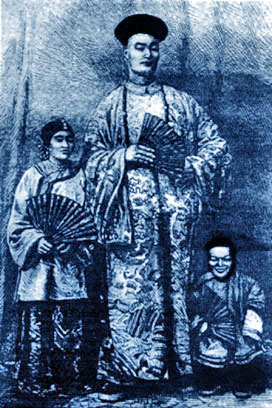|
Assam Giant
A human skeleton measuring eleven feet was found some years ago at Tura in Assam, near the border of East Pakistan, reports Peter Kolosimo.1
|
 |
|
CHANG WOO GOW, who became a sensation in Britain, was accompanied on his tours by his wife King-Foo and the dwarf Chung, his constant companion.
|
Chang Woo Gow
The Chinese giant Chang Woo Gow showed himself in England in 1865/1866 at the old Egyptian Hall in Piccadilly. A courtly gentleman and able scholar, he was invited to visit the Prince and Princess of Wales. He stood eight feet two inches. He was not the tallest in his family, however, for one sister measured eight feet four inches. On his British tour, the nineteen-year-old Chang was accompanied by his bride, King-Foo ("The Fair Lily") and by a three-foot dwarf named Chung, who always stood at his side during the giant's public appearances.2 (See Chinese Colossus; Chinese Giants, Other; Giants and Dwarfs; Melius, Angelina)
Chinese Colossus
Purchaas, in his Pilgrimes, 1625, says that while he was in China he saw a man who "was cloathed with a tyger's skin, the hayre outward, his armes, head, and legges bare, with a rude pole in his hand; well-shaped, seeming ten palmes or spans long, his hayre hanging on his shoulders."3 (See Chang Woo Gow; Chinese Giants, Other)
Chinese Giants, Other
The Chinese, in whose land archaeologists have found some of the earliest skeletal remains of giants, insist they once had among them some men as much as fifteen feet tall. We could dismiss this as just another tall tale, except that Melchior Nunnez, in his letters from India, vouches for the fact that China grew some giants to that tremendous size. He "speaks of porters who guarded the gates of Peking who were of that immense height; and in a letter dated in 1555, he avers that the emperor of that country entertained and fed five hundred of such men for archers of his guard."4 They were still there to be seen seventy years later, for George Hakewill, in his Apologie, 1627, issues a similar report.5 (See Chang Woo Gow; Chinese Colossus)
Monstrous Tartar (See Tartar Giants)
Tartar Giants
In 1575, when the Tartars invaded Poland, Jacobus Niezabilo-vius slew a warrior of enormous size who fought in their ranks. After the battle, Polish soldiers marveled that as he lay dead on the ground "his body was of so prodigious a bulk that... his carcass reached to the navel of any ordinary person standing by the side of it."6 (See Graveyards of the Giants)
And James Paris du Plessis, in his Short History of Human Prodigies, Dwarfs, etc., reports that a Hungarian, known as the "Monstrous Tartar," was exhibited at "Ye Globe in the ould Baily in February 1664. He was taken prisoner by Count Serini and was a creature of extraordinary strength and valour, who, having spent all his arrows in fight against the Christians, was taken alive and so continues being carefully kept in those parts."7
References
1 Peter Kolosimo, Timeless Earth (New York: University Books, 1968), p. 32.
2 Thompson, Mystery and Lore of Monsters, pp. 181-182.
3 Ibid., p. 231.
4 No reference given.
5 No reference given.
6 Ibid.,pp. 95-96.
7 Thompson, Mystery and Lore of Monsters, p. 149
|

